2013 DACIA SANDERO child lock
[x] Cancel search: child lockPage 5 of 146
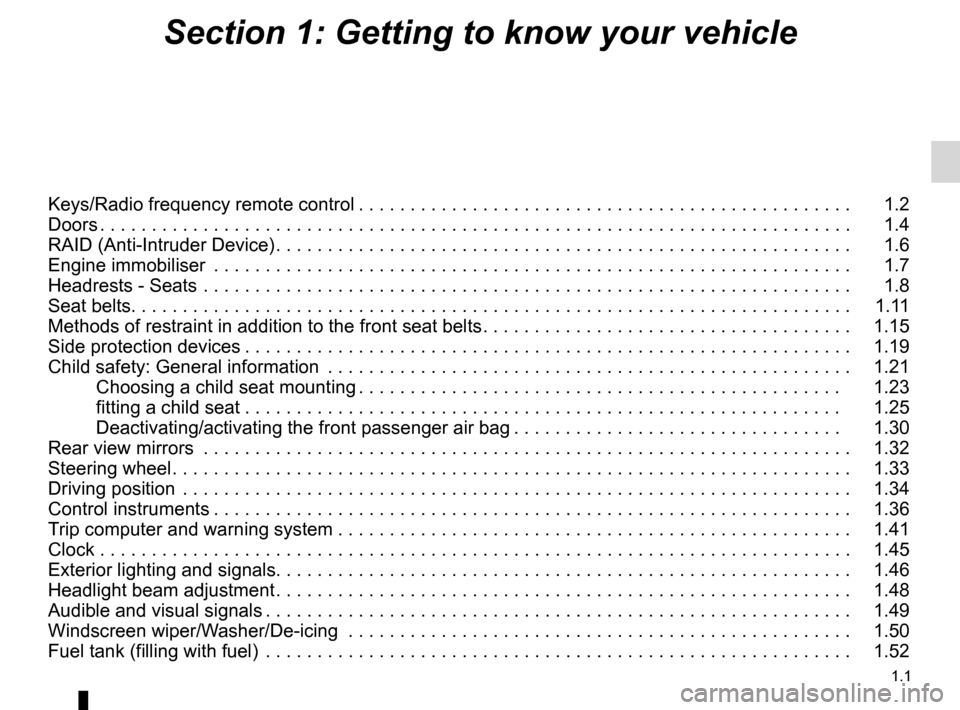
1.1
ENG_UD8701_2Sommaire 1 (B90 - Dacia)ENG_NU_817-2_NU_Dacia_1
Section 1: Getting to know your vehicle
Keys/Radio frequency remote control . . . . . . . . . . . . . . . . . . . . . . . . . . . . . . . . . . . . \
. . . . . . . . . . . . 1.2
Doors . . . . . . . . . . . . . . . . . . . . . . . . . . . . . . . . . . . . \
. . . . . . . . . . . . . . . . . . . . . . . . . . . . . . . . . . . . \
. 1.4
RAID (Anti-Intruder Device) . . . . . . . . . . . . . . . . . . . . . . . . . . . . . . . . . . . . \
. . . . . . . . . . . . . . . . . . . . 1.6
Engine immobiliser . . . . . . . . . . . . . . . . . . . . . . . . . . . . . . . . . . . .\
. . . . . . . . . . . . . . . . . . . . . . . . . . 1.7
Headrests - Seats . . . . . . . . . . . . . . . . . . . . . . . . . . . . . . . . . . . .\
. . . . . . . . . . . . . . . . . . . . . . . . . . . 1.8
Seat belts. . . . . . . . . . . . . . . . . . . . . . . . . . . . . . . . . . . . \
. . . . . . . . . . . . . . . . . . . . . . . . . . . . . . . . . . 1.11
Methods of restraint in addition to the front seat belts . . . . . . . . . . . . . . . . . . . . . . . . . . . . . . . . . . . . 1.15
Side protection devices . . . . . . . . . . . . . . . . . . . . . . . . . . . . . . . . . . . . \
. . . . . . . . . . . . . . . . . . . . . . . 1.19
Child safety: General information . . . . . . . . . . . . . . . . . . . . . . . . . . . . . . . . . . . .\
. . . . . . . . . . . . . . . 1.21
Choosing a child seat mounting . . . . . . . . . . . . . . . . . . . . . . . . . . . . . . . . . . . . \
. . . . . . . . . . . 1.23
fitting a child seat . . . . . . . . . . . . . . . . . . . . . . . . . . . . . . . . . . . . \
. . . . . . . . . . . . . . . . . . . . . . 1.25
Deactivating/activating the front passenger air bag . . . . . . . . . . . . . . . . . . . . . . . . . . . . . . . . 1.30
Rear view mirrors . . . . . . . . . . . . . . . . . . . . . . . . . . . . . . . . . . . .\
. . . . . . . . . . . . . . . . . . . . . . . . . . . 1.32
Steering wheel . . . . . . . . . . . . . . . . . . . . . . . . . . . . . . . . . . . . \
. . . . . . . . . . . . . . . . . . . . . . . . . . . . . . 1.33
Driving position . . . . . . . . . . . . . . . . . . . . . . . . . . . . . . . . . . . .\
. . . . . . . . . . . . . . . . . . . . . . . . . . . . . 1.34
Control instruments . . . . . . . . . . . . . . . . . . . . . . . . . . . . . . . . . . . . \
. . . . . . . . . . . . . . . . . . . . . . . . . . 1.36
Trip computer and warning system . . . . . . . . . . . . . . . . . . . . . . . . . . . . . . . . . . . . \
. . . . . . . . . . . . . . 1.41
Clock . . . . . . . . . . . . . . . . . . . . . . . . . . . . . . . . . . . .\
. . . . . . . . . . . . . . . . . . . . . . . . . . . . . . . . . . . .\
. 1.45
Exterior lighting and signals. . . . . . . . . . . . . . . . . . . . . . . . . . . . . . . . . . . . \
. . . . . . . . . . . . . . . . . . . . 1.46
Headlight beam adjustment . . . . . . . . . . . . . . . . . . . . . . . . . . . . . . . . . . . . \
. . . . . . . . . . . . . . . . . . . . 1.48
Audible and visual signals . . . . . . . . . . . . . . . . . . . . . . . . . . . . . . . . . . . . \
. . . . . . . . . . . . . . . . . . . . . 1.49
Windscreen wiper/Washer/De-icing . . . . . . . . . . . . . . . . . . . . . . . . . . . . . . . . . . . .\
. . . . . . . . . . . . . 1.50
Fuel tank (filling with fuel) . . . . . . . . . . . . . . . . . . . . . . . . . . . . . . . . . . . .\
. . . . . . . . . . . . . . . . . . . . . 1.52
Page 6 of 146
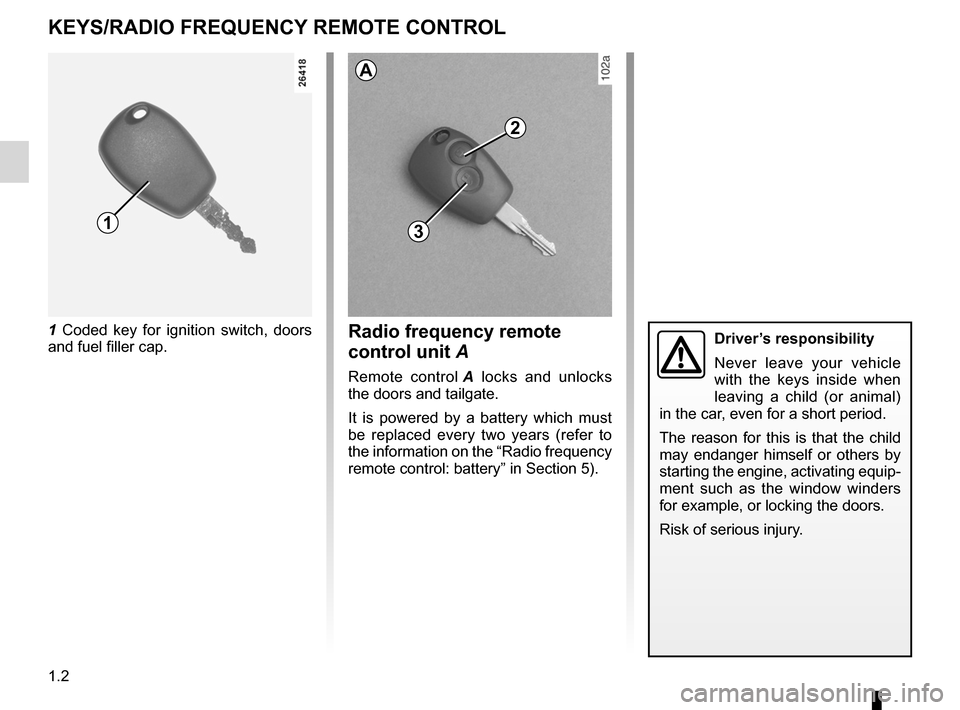
keys ......................................................(up to the end of the DU)remote control door locking unit ............................(current page)
1.2
ENG_UD7223_2Clés / télécommande à radiofréquence (B90 - L90 - F90 - \
U90 - R90 - L90 Ph2 - Dacia)ENG_NU_817-2_NU_Dacia_1
JauneNoirNoir texte
Clés / Télécommande à radiofréquence
KEYS/RADIO FREQUENCY REMOTE CONTROL
Radio frequency remote
control unit
A
Remote control A locks and unlocks the doors and tailgate.
It is powered by a battery which must be replaced every two years (refer to the information on the “Radio frequency remote control: battery” in Section 5).
Driver’s responsibility
Never leave your vehicle with the keys inside when leaving a child (or animal) in the car, even for a short period.
The reason for this is that the child may endanger himself or others by starting the engine, activating equip- ment such as the window winders for example, or locking the doors.
Risk of serious injury.
2
3
A
1 Coded key for ignition switch, doors and fuel filler cap.
1
Page 8 of 146

children .................................................(up to the end of the DU)doors.....................................................(up to the end of the DU)child safety............................................(up to the end of the DU)
1.4
ENG_UD5542_1Ouverture des portes (B90 - Dacia)ENG_NU_817-2_NU_Dacia_1
Portes
OPENING THE DOORS
Driver’s responsibility
Never leave your vehi- cle with the key inside and never leave a child (or a pet) unsupervised, even for a short while.
They may pose a risk to themselves
or to others by starting the engine, activating equipment such as the electric windows or by locking the doors.
Risk of serious injury.
Opening manually
from the outside
Depending on the vehicle, the key locks and unlocks the driver’s door or all four doors.
Front: use the key to unlock one of
the front door locks 2. Place your hand
behind handle 1 and pull it towards you.
Rear: lift unlocking button 3 from the inside and pull the door handle.
Opening manually
from the inside
Front: pull the handle 4
Rear: from the inside, lift unlocking
button 3 and pull the door handle 4.
Lights-on reminder buzzer
If you have left the lights on after switch- ing off the ignition, a warning buzzer will sound when a front door is opened (to prevent the battery from discharging, etc.).
21
3
4
Page 9 of 146

children .................................................(up to the end of the DU)doors.....................................................(up to the end of the DU)electric door locking ..............................(up to the end of the DU)central door locking ..............................(up to the end of the DU)
1.5
ENG_UD5543_1Verrouillage des portes (B90 - Dacia)ENG_NU_817-2_NU_Dacia_1
LOCKING THE DOORS
Manual locking
Front: use the key if outside or, if inside,
press down knob 1 when the door is closed.
Rear: press down button 1 in each door.
Electric central locking
Depending on the vehicle, this is used to simultaneously lock the four doors and luggage compartment.
Press the bottom of switch
2 to lock.
The front door mechanism cannot be locked if the door is open.
Childproof locks
To make it impossible for the rear doors to be opened from the inside, move
lever 3 on each door and check from the inside that the doors are securely locked.
If you decide to keep the doors locked when you are driving, remember that it may be more difficult for those assisting you to gain access to the passenger compartment in the event of an emergency.
3
21
Page 22 of 146
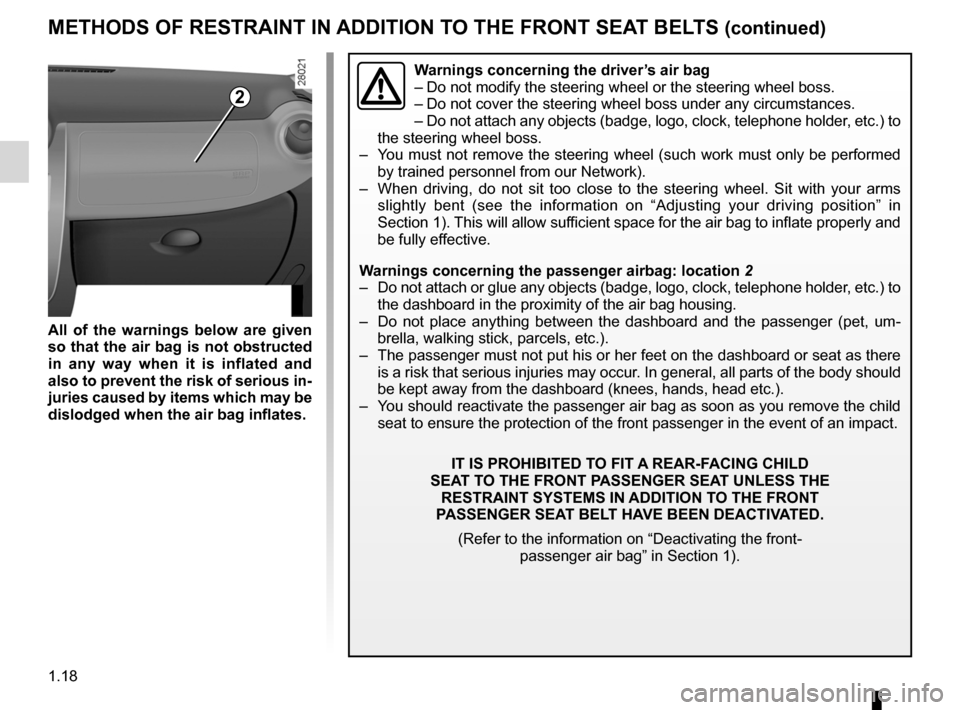
1.18
ENG_UD8379_3Dispositifs complémentaires à la ceinture avant (B90 - L90 Ph2 - \
Dacia)ENG_NU_817-2_NU_Dacia_1
METHODS OF RESTRAINT IN ADDITION TO THE FRONT SEAT BELTS (continued)
All of the warnings below are given so that the air bag is not obstructed in any way when it is inflated and also to prevent the risk of serious in- juries caused by items which may be dislodged when the air bag inflates.
warnings concerning the driver’s air bag
– Do not modify the steering wheel or the steering wheel boss.
– Do not cover the steering wheel boss under any circumstances.
– Do not attach any objects (badge, logo, clock, telephone holder, etc.) to
the steering wheel boss.
– You must not remove the steering wheel (such work must only be performed by trained personnel from our Network).
– When driving, do not sit too close to the steering wheel. Sit with your arms slightly bent (see the information on “Adjusting your driving position” in
Section 1). This will allow sufficient space for the air bag to inflate properly and be fully effective.
w arnings concerning the passenger airbag: location
2
– Do not attach or glue any objects (badge, logo, clock, telephone holder, etc.) to the dashboard in the proximity of the air bag housing.
– Do not place anything between the dashboard and the passenger (pet, um- brella, walking stick, parcels, etc.).
– The passenger must not put his or her feet on the dashboard or seat as there is a risk that serious injuries may occur. In general, all parts of the body should be kept away from the dashboard (knees, hands, head etc.).
– You should reactivate the passenger air bag as soon as you remove the child seat to ensure the protection of the front passenger in the event of an \
impact.
IT IS PROHIBITED TO FIT A REAR-FACING CHILD SEAT TO THE FRONT PASSENGER SEAT UNLESS THE RESTRAINT SYSTEMS IN ADDITION TO THE FRONT
PASSENGER SEAT BELT HA vE BEEN DEACTIvATED.
(Refer to the information on “Deactivating the front- passenger air bag” in Section 1).
2
Page 25 of 146
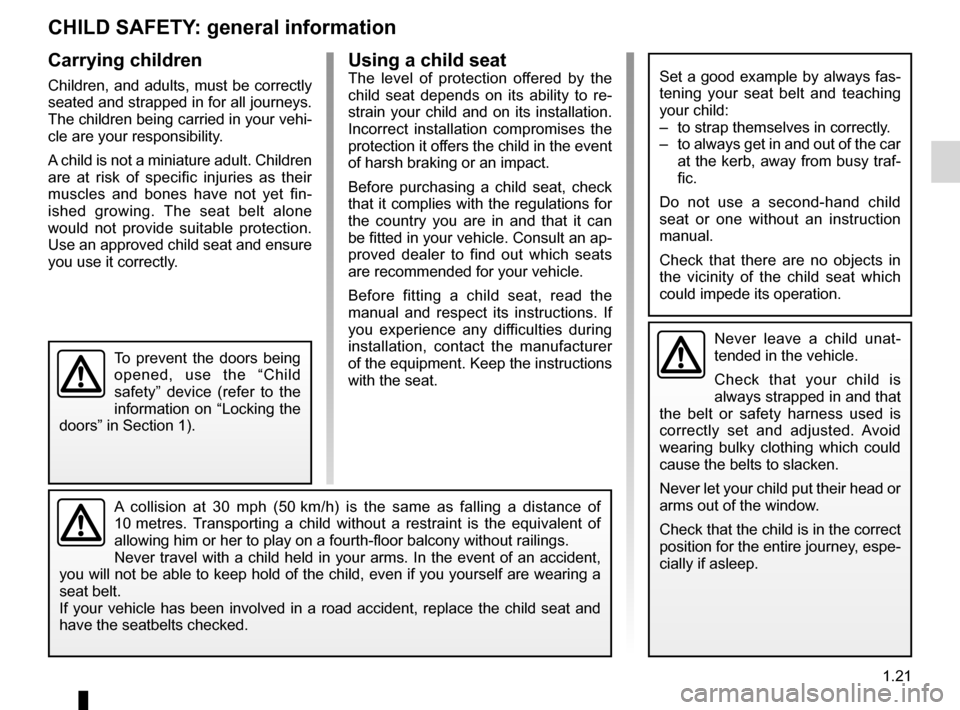
child restraint/seat ................................(up to the end of the DU)child restraint/seat ................................(up to the end of the DU)child restraint/seat ................................(up to the end of the DU)child seats.............................................(up to the end of the DU)child booster seat .................................(up to the end of the DU)transporting children .............................(up to the end of the DU)child safety............................................(up to the end of the DU)
1.21
ENG_UD7556_2Sécurite enfants : généralités (B90 - F90 - R90 - L90 Ph2 -\
Dacia)ENG_NU_817-2_NU_Dacia_1
Child safety: general information
CHILD SAFETY : general information
Carrying children
Children, and adults, must be correctly seated and strapped in for all journeys. The children being carried in your vehi- cle are your responsibility.
A child is not a miniature adult. Children are at risk of specific injuries as their muscles and bones have not yet fin- ished growing. The seat belt alone would not provide suitable protection. Use an approved child seat and ensure you use it correctly.
A collision at 30 mph (50 km/h) is the same as falling a distance of
10 metres. Transporting a child without a restraint is the equivalent of allowing him or her to play on a fourth-floor balcony without railings.Never travel with a child held in your arms. In the event of an accident, you will not be able to keep hold of the child, even if you yourself are wearing a seat belt.
If your vehicle has been involved in a road accident, replace the child seat and have the seatbelts checked.
Never leave a child unat- tended in the vehicle.
Check that your child is always strapped in and that the belt or safety harness used is correctly set and adjusted. Avoid wearing bulky clothing which could cause the belts to slacken.
Never let your child put their head or arms out of the window.
Check that the child is in the correct position for the entire journey, espe- cially if asleep.
Set a good example by always fas- tening your seat belt and teaching your child:
– to strap themselves in correctly.
– to always get in and out of the car
at the kerb, away from busy traf- fic.
Do not use a second-hand child seat or one without an instruction manual.
Check that there are no objects in the vicinity of the child seat which could impede its operation.
To prevent the doors being opened, use the “Child safety” device (refer to the information on “Locking the doors” in Section 1).
Using a child seatThe level of protection offered by the child seat depends on its ability to re- strain your child and on its installation. Incorrect installation compromises the protection it offers the child in the event of harsh braking or an impact.
Before purchasing a child seat, check that it complies with the regulations for the country you are in and that it can be fitted in your vehicle. Consult an ap- proved dealer to find out which seats are recommended for your vehicle.
Before fitting a child seat, read the manual and respect its instructions. If you experience any difficulties during installation, contact the manufacturer of the equipment. Keep the instructions with the seat.
Page 27 of 146

child restraint/seat ................................(up to the end of the DU)child restraint/seat ................................(up to the end of the DU)child restraint/seat ................................(up to the end of the DU)child safety............................................(up to the end of the DU)child seats.............................................(up to the end of the DU)transporting children .............................(up to the end of the DU)
1.23
ENG_UD8388_2Sécurité enfants : choix de la fixation du siège enfant (B90 -\
Dacia)ENG_NU_817-2_NU_Dacia_1
Choosing a child seat mounting
CHILD SAFETY : choosing a child seat mounting
The are two ways of attaching child seats: via the seat belt or using the ISOFIX system.
Attachment via the seat belt
The seat belt must be adjusted to ensure that it is effective in the event of harsh braking or an impact.
Ensure that the strap paths indicated by the child seat manufacturer are re- spected.
Always check that the seat belt is cor- rectly fastened by pulling it up, then pulling it out fully whilst pressing on the child seat.
Check that the seat is correctly held by moving it from side to side and back to front: the seat should remain firmly fixed.
Check that the child seat has not been installed at an angle and that it is not resting against a window.
Attachment with the ISOFIX system
Authorised ISOFIX child seats are ap- proved in accordance with regulation ECE-R44 in one of the three following scenarios:
– ISOFIX universal 3-point forward- facing seat
– ISOFIX semi-universal 2-point seat
– specific
For the latter two, check that your child seat can be installed by consulting the list of compatible vehicles.
Attach the child seat with the ISOFIX locks, if these are provided. The ISOFIX system allows quick, easy, safe fitting.
The ISOFIX system consists of 2 rings.
Before using an ISOFIX
child seat that you pur- chased for another vehicle, check that its installation is authorised. Consult the list of vehi- cles which can be fitted with the seat with the equipment manufacturer.
No modifications may be made to the component parts of the restraint system (belts, ISOFIX and seats and their mountings) originally fitted.
The seat belt must never be twisted or the tension relieved. Never pass the shoulder strap under the arm or behind the back.Check that the seat belt has not been damaged by sharp edges.If the seat belt does not operate nor- mally, it will not protect the child. Consult an approved dealer. Do not use this seat until the seat belt has been repaired.
Do not use the child seat if it may unfasten the seat belt restraining it: the base of the seat must not rest on the buckle and/or catch of the seat belt.
Page 28 of 146
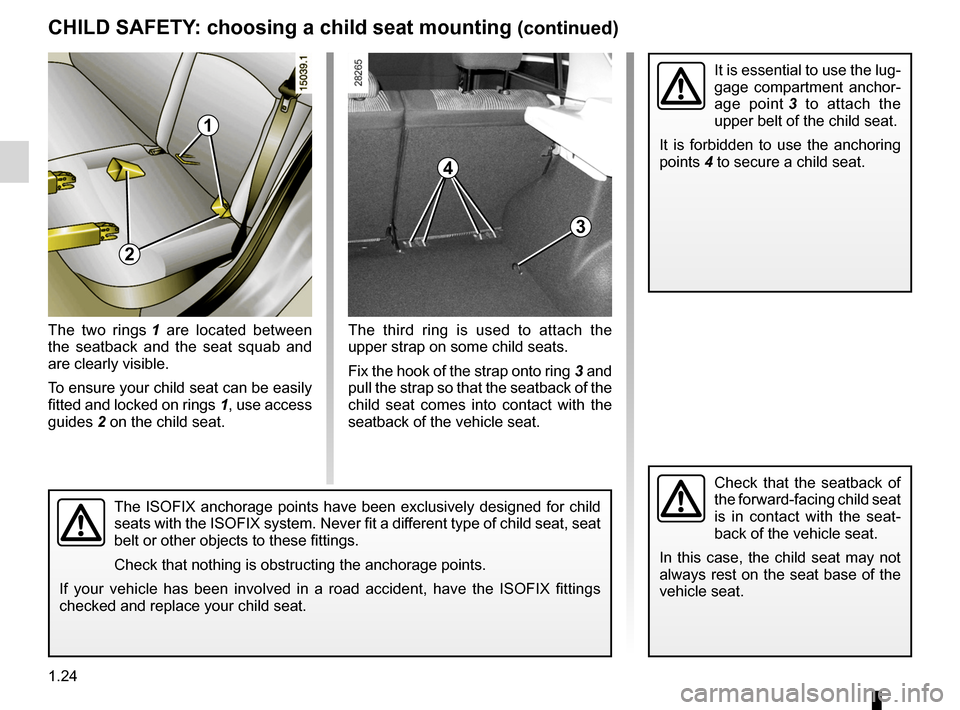
1.24
ENG_UD8388_2Sécurité enfants : choix de la fixation du siège enfant (B90 -\
Dacia)ENG_NU_817-2_NU_Dacia_1
The third ring is used to attach the upper strap on some child seats.
Fix the hook of the strap onto ring
3 and pull the strap so that the seatback of the child seat comes into contact with the seatback of the vehicle seat.
The two rings
1 are located between the seatback and the seat squab and are clearly visible.
To ensure your child seat can be easily
fitted and locked on rings 1, use access
guides 2 on the child seat.
CHILD SAFETY : choosing a child seat mounting (continued)
The ISOFIX anchorage points have been exclusively designed for child seats with the ISOFIX system. Never fit a different type of child seat, seat belt or other objects to these fittings.
Check that nothing is obstructing the anchorage points.
If your vehicle has been involved in a road accident, have the ISOFIX fittings
checked and replace your child seat.
Check that the seatback of
the forward-facing child seat is in contact with the seat- back of the vehicle seat.
In this case, the child seat may not always rest on the seat base of the vehicle seat.
1
2
3
It is essential to use the lug- gage compartment anchor-
age point 3 to attach the upper belt of the child seat.
It is forbidden to use the anchoring
points 4 to secure a child seat.4